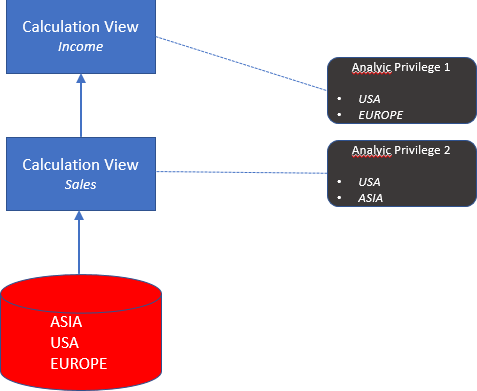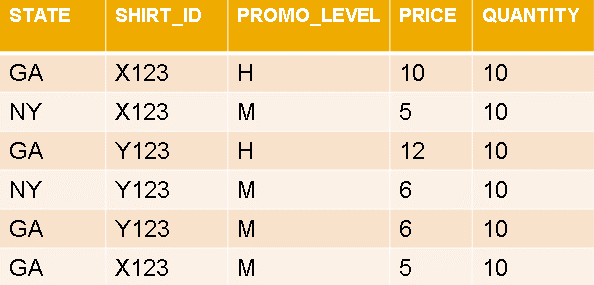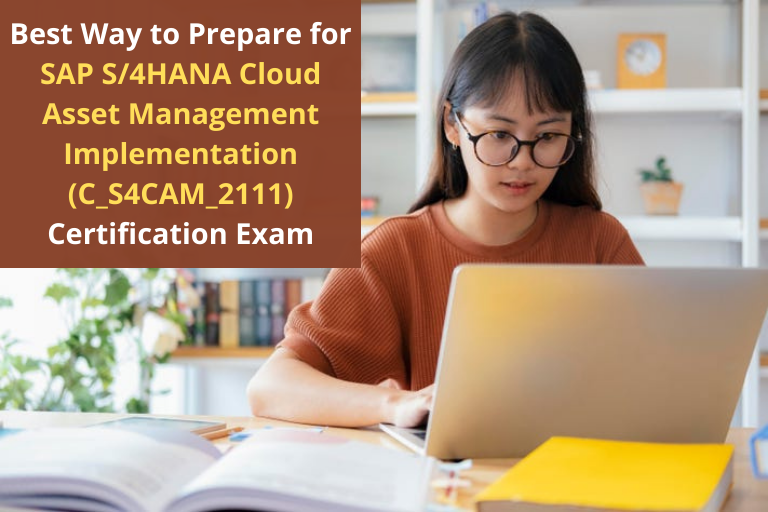|
Introduction to SAP Certified Application Associate - SAP HANA Cloud Modeling Exam HANA Cloud Modeling (C_HCMOD_02) preparation guide helps you to get focused on exam. This guide also helps you to be on C_HCMOD_02 exam track to get certified with good score in the final exam. C_HCMOD_02 HANA Cloud Modeling Exam Summary
Understanding SAP BTP and SAP HANA Cloud concepts and technologies of the SAP HANA Cloud, SAP HANA database Books: HC100e OR Modeling Learning Room 2. Build calculation views Creating all types of calculation views using nodes Books: HC300e OR Modeling Learning Room 3. Configuring modeling functions Defining filters, calculated columns, restricted columns, hierarchies, variables, input parameters and currency conversion in calculation views. Books: HC300e OR Modeling Learning Room 4. Manage and administer models Deploying modeling content, administration of calculation views, defining new projects, namespaces, cross-container access, and working with Git Books: HC300e OR Modeling Learning Room 5. Optimize performance of models Following modeling best practices and using performance monitoring tools Books: HC300e OR Modeling Learning Room 6. Secure data models Defining roles, analytic privileges and data privacy settings Books: HC300e OR Modeling Learning Room 7. SQLScript in models Implementing custom SQL in calculation views Books: HC300e OR Modeling Learning Room SAP C_HCMOD_02 Certification Sample Questions and AnswersTo make you familiar with HANA Cloud Modeling (C_HCMOD_02) certification exam structure, we have prepared this sample question set. We suggest you to try our Sample Questions for HCMOD C_HCMOD_02 Certification to test your understanding of SAP C_HCMOD_02process with real SAP certification exam environment. C_HCMOD_02 HANA Cloud Modeling Sample Questions:-01. Why do you implement column tables instead of row tables? There are 2 correct answers to this question. a) Data volumes are large b) Data is suitable for partitioning c) High performance for transaction processing is required d) Records will be updated frequently Answer: a, b 02. How can you define a variable that displays its value help organized as a hierarchy? There are 2 correct answers to this question. a) Create a parent-child hierarchy and assign it to the variable. Ensure the variable's reference column is the child attribute of the hierarchy. b) Create a parent-child hierarchy and assign it to the variable. Ensure the variable's reference column is the parent attribute of the hierarchy. c) Create a level hierarchy and assign it to the variable. Ensure the variable's reference column is the leaf level of the hierarchy. d) Create a level hierarchy and assign it to the variable. Ensure the variable's reference column is the top level of the hierarchy. Answer: b, c 03. Which of the following are types of calculation view can you create in SAP HANA Cloud? There are 2 correct answers to this question. a) Dimension b) SQL Access Only c) Cube d) Composite Answer: a, c 04. In a calculation view, you use a rank node to identify the purchase orders with the highest total amount. The expected output includes the top orders that represent 15% of the total numbers of orders placed by each customer. How do you set the Aggregation Function and Result Set Type properties of the rank node to get the expected result? Please choose the correct answer. a) Aggregation Function: Sum Result Set Type: Percentage b) Aggregation Function: Sum Result Set Type: Absolute c) Aggregation Function: Row Result Set Type: Percentage d) Aggregation Function: Rank Result Set Type: Absolute Answer: c 05. Which of these cloud providers are supported by the multi-cloud SAP BTP environment? Please choose the correct answer. a) Alibaba Cloud AWS Google Cloud Platform Microsoft Azure b) Alibaba Cloud AWS IBM Cloud Platform Microsoft Azure c) AWS Google Cloud Platform IBM Cloud Platform Microsoft Azure d) Alibaba Cloud Google Cloud Platform IBM Cloud Platform Microsoft Azure Answer: a 06. Which of the following approaches can be used to implement union pruning? There are 2 correct answers to this question. a) Define union pruning conditions in a pruning configuration table. b) Define a restricted column and include it in both data sources of a union. c) Define a constant value for each data source in the Union node. d) Define the cardinality between the data sources. Answer: a, c 07. What can you discover using Data Lineage? Please choose the correct answer. a) Data changes since last refresh b) Frequency of load c) Underlying calculation views and tables d) Access statistics Answer: c 08. What does SQLScript provide to extend standard SQL? There are 2 correct answers to this question. a) Features to push processing to the database b) Additional data types for the definition of text and spatial data c) Integrated source code version management d) Support for ABAP syntax Answer: a, b 09. Which of the following tasks are required to generate the database objects in the HDI container? There are 2 correct answers to this question. a) Build the HDB module. b) Build the project. c) Create at least one namespace in the HDB module. d) Assign the project to a space. Answer: a, d
0 Comments
Start Your Preparation for SAP Data Integration with SAP Data Services (C_DS_42) Certification Exam8/31/2022 Introduction to SAP Certified Application Associate - Data Integration with SAP Data Services Exam Data Integration with SAP Data Services (C_DS_42) preparation guide helps you to get focused on exam. This guide also helps you to be on C_DS_42 exam track to get certified with good score in the final exam. C_DS_42 Data Integration with SAP Data Services Exam Summary
Manage repositories, setup Data Stores and use the data services management console, install and configure data services, set up file formats, schedule jobs, manage Security in Data Services, and use Data Services Workbench. Books:
Optimize data flow for performance and measure performance, use parallel processing, push down operations, and distribute Data Flow execution across Job Servers; configure Bulk Loaders. Books:
Use Target table options, built-in functions, the platform, validation and Query transforms, create batch jobs, describe data services object hierarchy/relationsihp and operation codes. Books: DS10 (DATA SERVICES 4.2 SP8) 4. Recovery and Troubleshooting Design recovery, troubleshoot/test jobs, apply error handling, explain Trace logs, and use the interactive debugger. Books: DS10 (DATA SERVICES 4.2 SP8) 5. Complex Design Methodology Design the interdependancies within a workflow, use workflows to control the execution of the job, and implement Datastore configurations and System Configurations. Books:
Apply data integrator transforms, audit data flows, and use scripting and embedded Data Flows. Books:
Descibe ETL Project Guidelines, Real-Time processing, and profile data in Data Services. Books:
Compare Delta Load Methods, and implement source based Change Data Capture and target based Change Data Capture. Books:
C_DS_42 Data Integration with SAP Data Services Sample Questions:- 01. An SAP Data Services dataflow contains multiple transform objects. The target table contains some unexpected results for one column. How can you review a sample of the data as it passes through each transform? Please choose the correct answer. a) Execute the job and review the monitor during execution. b) Execute the job and review the target table in SQL. c) Execute the job that enables the Trace Optimized Dataflow property. d) Execute the job in debug mode with breakpoints set and enabled. Answer: d 02. You have a Salary table containing departments (DEPARTMENT column) and salaries (SALARY column). How do you calculate the average salaries for each department in the Query transform in SAP Data Services? There are 2 correct answers to this question. a) Enter avg(SALARY) on the Mapping tab. b) Specify the DEPARTMENT column on the GROUP BY tab. c) Enter avg(SALARY) on the SELECT tab. d) Specify the DEPARTMENT code on the WHERE tab. Answer: a, b 03. During development of a SAP Data Services dataflow, you find that the source system contains data inconsistencies. What transform allows you to define rules and monitor the conformance of the data for every load? Please choose the correct answer. a) Query transform b) Case transform c) Validation transform d) SQL transform Answer: c 04. Your customer has rules requiring that each row in the source be tested for certain criteria in a specific order. When a row passes one criteria, it should NOT be tested for the next criteria. How should this be implemented using SAP Data Services transforms? Please choose the correct answer. a) Use a Validation transform and add the rules in the proper order for each single column. b) Use a Case transform with the Produce Default Output with Label option enabled, and enable the Preserve Expression Order checkbox. c) Use a Case transform with the Row Can Be True for One Case Only and Preserve Expression Order options enabled. d) Use multiple Query transforms with one WHERE? clause per rule. Connect all queries to the source. Answer: c 05. You are designing an SAP Data Services process. This process must execute ONLY if a defined expression is true. Which object allows you to accomplish this task? Please choose the correct answer. a) Validation transform b) Case transform c) Try/catch block d) Conditional Answer: d 06. Which syntax rules must you follow in the SAP Data Services scripting language? There are 2 correct answers to this question. a) A statement ends with a dot sign (.). b) A variable starts with a percent sign (%). c) A variable starts with a dollar sign ($). d) A comment starts with a hash (#). Answer: c, d 07. Where is an SAP Data Services job executed? Please choose the correct answer. a) Management console b) Job server c) Access server d) Designer application Answer: b 08. Which SAP Data Services transforms would you use in a dataflow to load a slowly changing dimension of type 2? There are 3 correct answers to this question. a) Effective_Date b) Row_Generation c) Table_Comparison d) Key_Generation e) History_Preserving Answer: c, d, e 09. What are characteristics of SAP Data Services workflows? There are 2 correct answers to this question. a) A workflow can contain a conditional object. b) A job needs to have at least one workflow. c) A workflow must contain a dataflow. d) A workflow can call other workflows. Answer: a, d 10. You want to restore an older version of an object found in a shared object library. Where do you find this version of the object in SAP Data Services? Please choose the correct answer. a) In the Profiler repository b) In the Auditing repository c) In the Local repository d) In the Central repository Answer: d Introduction to SAP Certified Application Associate - SAP S/4HANA Cloud - Public - Finance Implementation Exam
S/4HANA Cloud Public Finance Implementation (C_S4CFI_2208) preparation guide helps you to get focused on exam. This guide also helps you to be on C_S4CFI_2208 exam track to get certified with good score in the final exam.
Introduction to SAP Certified Application Associate - SAP HANA 2.0 SPS06 Exam
HANA Application (C_HANAIMP_18) preparation guide helps you to get focused on exam. This guide also helps you to be on C_HANAIMP_18 exam track to get certified with good score in the final exam.​
Exam Syllabus: C_HANAIMP_18 SAP Certified Application Associate - SAP HANA 2.0 SPS061. Describing the Technology and Deployment Scenarios of SAP HANA Demonstrate an understanding of the key technology of SAP HANA Books: HA100 OR LH – LR SAP HANA Modeling 2. Building calculation views Demonstrate detailed knowldege of building a data model using all types of calculation views and nodes. Books: HA300 OR LH – LR SAP HANA Modeling 3. Configuring modeling functions Demonstrate that you can implement common calculation view modeling functions, such as filters, parameters and hierarchies. Books: HA300 OR LH – LR SAP HANA Modeling 4. Optimizing the performance of models Demonstrate that you can follow best practices for building high performance models and use the provided tools to monitor performance. Books: HA300 OR LH – LR SAP HANA Modeling 5. Managing and administering models Demonstrate that you can setup the modeling ennvironment and use the tools provided to manage the data models. Books: HA300 OR LH – LR SAP HANA Modeling 6. Working with SQL and SQL Script in models Demonstrate that you can apply SQL and SQLScript in SAP HANA modeling. Books: HA300 OR LH – LR SAP HANA Modeling 7. Securing models Demonstrate that you can implement security features to prevent unauthorised access to data models. Books: HA300 OR LH – LR SAP HANA Modeling SAP C_HANAIMP_18 Certification Sample Questions and AnswersTo make you familiar with HANA Application (C_HANAIMP_18) certification exam structure, we have prepared this sample question set. We suggest you to try our Sample Questions for HANA Application 2.0 (SPS06) C_HANAIMP_18 Certification to test your understanding of SAP C_HANAIMP_18process with real SAP certification exam environment. C_HANAIMP_18HANA Application Sample Questions:-01. What can you discover using Data Lineage? Please choose the correct answer. a) Access statistics b) Underlying calculation views and tables c) Frequency of load d) Data changes since last refresh Answer: b 02. In a calculation view, you use a rank node to identify the purchase orders with the highest total amount. The expected output includes the top orders that represent 15% of the total numbers of orders placed by each customer. How do you set the Aggregation Function and Result Set Type properties of the rank node to get the expected result? Please choose the correct answer. a) Aggregation Function: Sum Result Set Type: Absolute b) Aggregation Function: Rank Result Set Type: Absolute c) Aggregation Function: Row Result Set Type: Percentage d) Aggregation Function: Sum Result Set Type: Percentage Answer: c 03. Which of the following approaches can be used to implement union pruning? There are 2 correct answers to this question. a) Define a constant value for each data source in the Union node. b) Define a restricted column and include it in both data sources of a union. c) Define the cardinality between the data sources. d) Define union pruning conditions in a pruning configuration table. Answer: a, d 04. One SQL analytic privilege authorizes you to view data for Europe and the USA in the sales calculation view, and another one authorizes you to view data for Asia and the USA in the income calculation view. The income view uses the sales view as a data source. Both calculation views check SQL analytic privileges. What data can you visualize when consuming the income calculation view? Please choose the correct answer. a) Data from the USA b) Data from Europe and the USA c) Data from Europe, Asia, and the USA d) Data from Asia and the USA Answer: a 05. Why do you implement column tables instead of row tables? There are 2 correct answers to this question. a) Data volumes are large b) Data is suitable for partitioning c) High performance for transaction processing is required d) Records will be updated frequently Answer: a, b 06. What does SQLScript provide to extend standard SQL? There are 2 correct answers to this question. a) Integrated source code version management b) Support for ABAP syntax c) Additional data types for the definition of text and spatial data d) Features to push processing to the database Answer: c, d 07. In SAP HANA Series Data processing, what is the definition of a profile? Please choose the correct answer. a) A variant of data set, such as actual, forecast, or long-term plan b) The granularity of time intervals, such as day, hour, or minute c) The values that you are storing, such as temperature, energy consumption, or speed d) The object you collect data against, such as house, building, or town Answer: d 08. Which of the following tasks are required to get the database objects created in the HDI container? There are 2 correct answers to this question. a) Build the MTA project. b) Explicitly build the HDB module instead of the MTA project. c) Create at least one namespace in the HDB module. d) Assign the project to a space to which you have developer authorizations. Answer: b, d 09. Which of the following are types of calculation view? There are 2 correct answers to this question. a) Cube b) Virtual c) Dimension d) Composite Answer: a, c 10. You are building a cube calculation view with an aggregation node that calculates total sales, based on the data shown in the graphic. The price may vary based on SHIRT_ID and PROMO_LEVEL only. The calculation is Total Sales = PRICE * QUANTITY. How do you ensure accurate results, regardless of the columns in the query output? Please choose the correct answer. a) Set the Keep Flag property for SHIRT_ID b) Set the Dynamic Partition property for SHIRT_ID and PROMO_LEVEL. c) Set the Calculate before Aggregation property. d) Set the Keep Flag property for SHIRT_ID and PROMO_LEVEL. Answer: d Introduction to SAP Certified Application Associate - SAP Ariba Supply Chain Collaboration Exam Ariba Supply Chain Collaboration (C_ARSCC_2202) preparation guide helps you to get focused on exam. This guide also helps you to be on C_ARSCC_2202 exam track to get certified with good score in the final exam. C_ARSCC_2202 Ariba Supply Chain Collaboration Exam Summary
1. Purchase Order Collaboration, Consignment and Invoicing Explain the business case, features and set up process for Purchase Order Automation Books: AR930e 2. Subcontracting and Multi-tier Explain the business case, features and set up for Subcontracting Books: AR930e 3. Supplier Managed Inventory Explain the business case, features and set up process for Consignment Inventory Books: AR930e 4. Quality Collaboration Use the invoicing features in SAP Ariba Supply Chain Collaboration Books: AR930e 5. SAP Ariba Supply Chain Collaboration Overview Explain the business case for SAP Ariba Supply Chain Collaboration; Explain the delivery and implemenation models Books: AR930e 6. Forecast Collaboration Explain the business case, features and set up process for Forecast Collaboration Books: AR930e 7. Scheduling Agreement Explain the business case, features and set up process for Scheduling Agreement Release Books: AR930e 8. Returns Enable suppliers to use SAP Ariba Supply Chain Collaboration Books: AR930e SAP C_ARSCC_2202 Certification Sample Questions and Answers To make you familiar with Ariba Supply Chain Collaboration (C_ARSCC_2202) certification exam structure, we have prepared this sample question set. We suggest you to try our Sample Questions for ARSCC C_ARSCC_2202 Certification to test your understanding of SAP C_ARSCC_2202 process with real SAP certification exam environment. C_ARSCC_2202 Ariba Supply Chain Collaboration Sample Questions:-
01. Who is responsible for creating the component receipt in the subcontracting scenario? Please choose the correct answer. a) The logistics provider b) The freight carrier c) The supplier d) The buyer Answer: c 02. Quality Collaboration enables buyers and suppliers to achieve real-time bi-directional communication on which of the following? There are 2 correct answers to this question. a) Deviation notification b) Goods receipt review c) Inspection results d) Quality Certificate Answer: a, c 03. The detail screen of Individual Data Planning in Supplier Managed Inventory gives sellers the ability to enter which of the following quantities? Please choose the correct answer. a) Stock level quantity b) Planned shipment quantity c) Net requirements quantity d) In transit quantity Answer: b 04. Where in Ariba Network can a Supplier commit to a Forecast? There are 2 correct answers to this question. a) Planning Collaboration Tab b) Forecast Tab c) Reports Tab d) Extended Collaboration Tab Answer: a, b 05. A buyer wants to order a predefined quantity of material and receive it on a regular repetitive schedule. Which SAP Ariba Supply Chain Collaboration function do you suggest? Please choose the correct answer. a) Scheduling Agreement Releases b) Forecast Collaboration c) Order and Invoice Collaboration d) Manufacturing Planning Visibility Answer: a 06. Which of the following activities does the buyer perform in the order return process? There are 3 correct answers to this question. a) Return ship notice b) Return purchase order c) Return quality inspection d) Return credit memo e) Post goods return Answer: a, b, e 07. How is a replenishment order displayed on the supplier side in Ariba Network? Please choose the correct answer. a) Production Order b) Firmed Order c) Purchase Order d) Sales Order Answer: b 08. Which document will not replicate to a copy supplier in the multi-tier process? Please choose the correct answer. a) Purchase Order b) Order Confirmation c) Advance Ship Notice d) Invoice Answer: d 09. What are the options available when suppliers create an order confirmation in Ariba Network? There are 3 correct answers to this question. a) Deliver Line Item b) Update Line Items c) Approve Entire Order d) Confirm Entire Order e) Reject Entire Order Answer: b, d, e 10. A supplier needs to send a single ship notice containing multiple items from multiple purchase orders. Which SAP Ariba function do you suggest? Please choose the correct answer. a) Order Collaboration b) Consignment Collaboration c) Scheduling Agreement Release d) Items to Ship List Answer: d S/4HANA Cloud Asset Management Implementation (C_S4CAM_2111) preparation guide helps you to get focused on exam. This guide also helps you to be on C_S4CAM_2111 exam track to get certified with good score in the final exam. C_S4CAM_2111 S/4HANA Cloud Asset Management Implementation Exam Summary
1. Scope Item Level Configuration for Corrective, Emergency and Preventive Maintenance Configure the Best Practices scenario for Corrective Maintenance (BH1), Emergency Maintenance (BH2), and Preventive Maintenance (BJ2). Books: S4C70E (SAP S/4HANA CLOUD 2111) OR SAP S/4HANA Cloud Implement. LR 2. Configuration and Reporting Identify the implementation phases and scope and perform key Guided Configuration; describe Expert Configuration; explain SAP Cloud Platform Identity Authentication Service; perform core user management in SAP S/4HANA Cloud; and identify Key Solution configuration settings for integration. Books: S4C01E (SAP S/4HANA CLOUD 2111) OR SAP S/4HANA Cloud Implement. LR 3. SAP Activate Methodology and Best Practices Describe the SAP Activate Implementation Methodology, best practices and Content Lifecycle Management for RISE with SAP S/4HANA Cloud (public). Books: S4C01E (SAP S/4HANA CLOUD 2111) OR SAP S/4HANA Cloud Implement. LR 4. SAP S/4HANA Cloud (public) Enterprise Asset Management Overview Describe the RISE with SAP strategy and solution scope for RISE with SAP S/4HANA Cloud (public) in general for SAP Asset Management solution and innovations. Books: S4CP01 (2021 (OP) AND 2111 (CLOUD)) S4C70E (SAP S/4HANA CLOUD 2111) OR SAP S/4HANA Cloud Implement. LR 5. Business Process Testing Describe the concepts of Business Process Testing and prepare and execute a Business Process Test Plan. Books: S4C01E (SAP S/4HANA CLOUD 2111) OR SAP S/4HANA Cloud Implement. LR 6. Data Migration Identify Self-Service Configuration UIs for data migration, prepare data migration, perform data migration, and describe best practices for managing data migration between release lifecycles. Books: S4C01E (SAP S/4HANA CLOUD 2111) OR SAP S/4HANA Cloud Implement. LR 7. Integration and Extensibility Describe the concepts of extensibility and integration and their implementations. Books: S4C01E (SAP S/4HANA CLOUD 2111) OR SAP S/4HANA Cloud Implement. LR SAP C_S4CAM_2111 Certification Sample Questions and Answers To make you familiar with S/4HANA Cloud Asset Management Implementation (C_S4CAM_2111) certification exam structure, we have prepared this sample question set. We suggest you to try our Sample Questions for S/4HANA Cloud Asset Management Implementation C_S4CAM_2111 Certification to test your understanding of SAP C_S4CAM_2111process with real SAP certification exam environment. C_S4CAM_2111S/4HANA Cloud Asset Management Implementation Sample Questions:- 01. According to the SAP Activate methodology, in which phase are the scope item Fit-to-Standard workshops executed? Please choose the correct answer. a) Prepare b) Realize c) Deploy d) Explore Answer: d 02. What capabilities are available in SAP Central Business Configuration? There are 2 correct answers to this question. a) Provision the quality and production system b) Deploy the solution scope c) Maintain Business Users d) Migrate data Answer: a, b 03. Where can you view the activated SAP Best Practice processes? Please choose the correct answer. a) SAP Best Practices Explorer b) SAP Solution Builder c) SAP S/4HANA Cloud Manage Your Solution app d) SAP Central Business Configuration Answer: d 04. What is difference between the public and private editions of SAP S/4HANA Cloud? Please choose the correct answer. a) Extensibility with PaaS b) Subscription licensing c) The SAP HANA database d) The release cycle Answer: d 05. Which of the following are process steps within emergency maintenance? Please choose the correct answer. a) Report and Repair Malfunction b) Preventive Maintenance of Technical Objects c) Scheduling of Maintenance Plans d) Early Warning for Failures of a piece of Equipment Answer: a 06. Which activity is part of Maintenance Execution? Please choose the correct answer. a) Creating master data records like equipment and functional locations. b) Creating structure indicators for the functional locations. c) Entering measurement readings that lead to creation of measurement documents. d) Planning the resources for upcoming maintenance work. Answer: c 07. You want to expand your sales in SAP S/4HANA Cloud to a new legal entity. To allow sales through this new legal entity, what additional organizational units must be created? There are 2 correct answers to this question. a) A company code b) A plant c) A shipping point d) A sales organization Answer: a, d 08. Which business objects were initially released as part of the SAP One Domain Model? There are 2 correct answers to this question. a) Workforce person b) Supplier c) Business partner d) Cost center Answer: a, d 09. What is the purpose of the malfunction report in an emergency maintenance process? Please choose the correct answer. a) It is used to capture the details of the failure of a technical object b) It is used to schedule maintenance work c) It is used by technicians to send alerts when a technical object breaks down d) It is used by maintenance planners to assign work Answer: a 10. What can you do with the help of the Request Maintenance SAP Fiori app? Please choose the correct answer. a) Display the relevant maintenance plan and item. b) Describe the damages and causes by choosing appropriate codes. c) Find the affected technical object using the type ahead search. d) Search for notifications. Answer: c Programming in SAP S/4HANA for SAP NetWeaver ABAP Programmer (C_S4HDEV1909) preparation guide helps you to get focused on exam. This guide also helps you to be on C_S4HDEV1909 exam track to get certified with good score in the final exam. C_S4HDEV1909 Programming in SAP S/4HANA for SAP NetWeaver ABAP Programmer Exam Summary
1. Expression-based ABAP syntax Use expression-based syntax for string processing, constructing objects and values, and assigning values Books: D75AW (SAP NETWEAVER 7.51) 2. ABAP SQL Explain the syntactical changes and functional enhancements of ABAP SQL Books: HA400 (SAP HANA 2.0 SPS05) 3. CDS views Define and use views in ABAP Core Data Services (CDS) Books:
4. in-App Extensibility Use SAP Fiori runtime authoring. Create data source extensions. Create custom fields. Create custom logic. Create custom business objects. Create a UI for a custom business object. Add custom logic to a custom business object. Transport extension items. Books: S4D425 (SAP S/4HANA 1809) 5. Analysis tools Explain the various analysis tools, specifically ATC, SQLM, SWLT, SAT, ST05, and ABAP Call Monitor (SCMON) Books:
6. ABAP Restful Application Programming (RAP) model Describe the use of the ABAP Restful Application Programming (RAP) model in ABAP development Books: openSAP CP13 7. CDS-based BOPF Define CDS-based Business Objects in the BOPF and implement their behavior Books: S4D435 (SAP S/4HANA 1809) 8. SAP Fiori use in ABAP Programming model Explain the usage of SAP Fiori in the ABAP Programming Model (CDS-based BOPF) Books: S4DEV (SAP S/4HANA 1909) 9. SAP Gateway use in ABAP Programming model Publish Gateway Services based on CDS Views Books: S4DEV (SAP S/4HANA 1909) 10. Custom code migration from SAP ERP to SAP S/4HANA Describe the impact of S/4HANA simplifications on custom code and tools to analyse the impact Books: S4D440 (SAP S/4HANA 1909) 11. ABAP Managed Database Procedures (AMDP) Define AMDPs and CDS table functions Books:
12. Side-by-Side Extensibility Explain the Cloud Platform Connectivity and Destination Service. Configure communication scenarios using the Communication Management. Create and use a custom remote client proxy in ABAP. Books: CLD400 SAP C_S4HDEV1909 Certification Sample Questions and Answers To make you familiar with Programming in SAP S/4HANA for SAP NetWeaver ABAP Programmer (C_S4HDEV1909) certification exam structure, we have prepared this sample question set. We suggest you to try our Sample Questions for S4HDEV C_S4HDEV1909 Certification to test your understanding of SAP C_S4HDEV1909process with real SAP certification exam environment. C_S4HDEV1909Programming in SAP S/4HANA for SAP NetWeaver ABAP Programmer Sample Questions:- 01. You use remote client proxy in ABAP. You create an Exception Class for errors related to proxy consumption. Which of the following do you use as a superclass? Please choose the correct answer. a) CX_WEB_MESSAGE_ERROR b) CX_RAP_QUERY_PROVIDER c) CX_HTTP_DEST_PROVIDER_ERROR d) CX_UUID_ERROR Answer: b 02. Which of the following new features are supported by the CDS Views but not by the ABAP Dictionary Views? There are 3 correct answers to this question. a) Aggregations and grouping b) Enhancement with custom fields c) Combining queries as inner join d) Nested views (View-on-View) e) Expressions in the field list Answer: a, d, e 03. You want to create custom fields using the Custom Fields and Logic extensibility app. Which of the following statements do you need to consider? There are 2 correct answers to this question. a) You must assign the fields to a business context. b) You can only use String-like data types for the fields. c) You can translate the fields into different languages. d) You must define the fields as read-only fields. Answer: a, c 04. You maintain a transactional application for flight travels that was developed with the ABAP RESTful Application Model (RAP Model). You want to offer an additional button for cancelling a travel. Which of the following building blocks need to be edited? There are 3 correct answers to this question. a) Service Definition b) Data Model Projection c) Behavior Projection d) Behavior Definition e) Data Model Answer: b, c, d 05. You have a field currcode in a CDS view definition. You want to annotate the field with a label. Which of the following are syntactically correct? There are 2 correct answers to this question. a) currcode, @>EndUserText.label: 'Currency Code' b) @<EndUserText.label: 'Currency Code' currcode, c) @EndUserText.label: 'Currency Code' currcode, d) currcode @<EndUserText.label: 'Currency Code' , Answer: c, d 06. What can you define in an SAP Fiori catalog? There are 2 correct answers to this question. a) Links b) Target Mappings c) Groups d) Tiles Answer: b, d 07. Where does the SAP system organize the SAP Gateway services? Please choose the correct answer. a) Internet Transaction Server (ITS) b) Internet Communication Framework (ICF) c) Internet Graphics Service (IGS) d) Internet Communication Manager (ICM) Answer: b 08. You maintain a transactional app that is built with the ABAP Programming model for SAP Fiori. The BOPF Business Object consists of a single node. You want to enable the CREATE button for new instances. In which of the following CDS objects do you have to add annotation @ObjectModel.createEnabled? There are 2 correct answers to this question. a) The data definition of the transactional view b) The data definition of the consumption view c) The data definition of the interface view d) The metadata extension of the consumption view Answer: a, b 09. You plan to migrate an SAP ERP system to SAP S/4HANA. Which of the following tasks are recommended but NOT mandatory? There are 2 correct answers to this question. a) Custom code evaluation b) Performance tuning c) SAP S/4HANA checks d) Functional adaption Answer: a, b 10. Which of the following make up the behavior of a BOPF Business Object? There are 3 correct answers to this question. a) Authorizations b) Validations c) Determinations d) Associations e) Actions Answer: b, c, Process Orchestration (C_PO_7521) preparation guide helps you to get focused on exam. This guide also helps you to be on C_PO_7521 exam track to get certified with good score in the final exam. C_PO_7521 Process Orchestration Exam Summary
Explain the difference between BPM, and Business Workflow, sequence diagrams, the perspectives in NWDS, Message Flow, Data Flow, Association, the Configuration of BPMN models; Model a business process List the BPMN types of Process Diagrams; Describe the elements of BPMN 2.0; Develop business processes and flow models. Books:
2. The Role of the Advanced Adapter Engine Extended (AEX) Define the Advanced Adapter Engine Extended (AEX), list the functionality of the Advanced Adapter Engine Extended (AEX); Explain how to Create an Advanced Adapter Engine Extended (AEX) integration flow. Books:
3. Basic Concepts System Landscape Directory (SLD) and Enterprise Service Repository (ESR) Describe the use of the System Landscape Directory (SLD), the Enterprise Service Repository (ESR), the Business systems & Technical systems and the use of Software Components in the ESR; Analyze Interface Objects in the Enterprise Services Repository. Books:
4. Mappings Explain how to create Message Mapping objects, the message and value mapping process and describe the types of mapping programs, describe how to create an operation mapping in the ESR and the default matcher. Books:
5. Operations and Process Monitoring in SAP Process Orchestration Explain how to Use the SAP NetWeaver Administrator functionality, the Operations tab in the NetWeaver Administrator, Certificates, Restart and Recovery and how to Access SAP Process Integration Monitoring; Start Business Processes; Define the Lifetime of Business Processes; Configure Process Orchestration in NetWeaver Administrator (NWA)Describe monitoring of the business processes and the AEX. Books:
6. Configuration of iFlows in NetWeaver Developer Studio (SAP NWDS) Describe the use of the perspective in SAP NetWeaver Developer Studio, and how data types are mapped in SAP NetWeaver Developer Studio; Describe data objects and iFlows; List the available data types; Describe Data Types in BPMN Processes. Books:
7. SAP Business Process Management Development Steps Outline the configuration of business processes. Books:
8. SAP Business Rules Management (BRM) Describe SAP Business Rules Management (BRM), the justification process for developing a new Business Rule and describe rulesets; Describe Rulesets. Books:
9. SAP Processes Integration Architecture Explain the difference between Process Orchestration and Process Integration, and how to establish the work environment for process creation; Describe the basic SAP Process Integration Architecture, the tools available for business process development, and message processing. Books:
10. Roles and Authorizations of a BPMN Process Describe Software Catalog (Products and Software Components), the SAP Component mode and the use of the Objects of the Component Model. Books:
11. Integration Objects in the Integration Directory Explain how to configure a scenario in the Integration Directory, how to process messages using the advanced adapter engine and the integration objects in the Integration Directory. Books:
12. Basic Concepts for SAP Business Process Management Integration Flow (iFlow) Explain process context. Books: BIT800 (SAP PROCESS ORCHESTRATION 7.50) SAP C_PO_7521 Certification Sample Questions and AnswersTo make you familiar with Process Orchestration (C_PO_7521) certification exam structure, we have prepared this sample question set. We suggest you to try our Sample Questions for Process Orchestration C_PO_7521 Certification to test your understanding of SAP C_PO_7521process with real SAP certification exam environment. C_PO_7521Process Orchestration Sample Questions:- 01. What do Business Rules represent? There are 3 correct answers to this question. a) The application business rules of an organization b) The constraints on behavior of the business c) A set of standard business practices d) A static component of any business e) The guidelines and core business logic. Answer: b, c, e 02. Which of the following are reusable objects in Business Process Management (BPM)? There are 3 correct answers to this question. a) Message types b) Data types c) Service interfaces d) Rules and functions e) Operation mapping Answer: b, c, d 03. During debugging of an integration process, which of the following logs allows you to search for exception IDs? Please choose the correct answer. a) Process log b) Connection log c) Business log d) J2EE Engine log Answer: d 04. Which organization created the specifications that the Business Process Modeling Notation (BPMN) is based on? Please choose the correct answer. a) The Business Process Modeling Corporation b) The Object Management Group c) The Apache Software Foundation d) The OASIS international open standards consortium Answer: b 05. Which algorithms does the advanced automapping functionality use to match the source and the target elements within an integration flow (iFlow)? There are 2 correct answers to this question. a) Attribute Matcher b) NamePath Matcher c) Child Matcher d) Leaf Matcher Answer: b, d 06. Which Connection Object characterizes the Data Flow in a BPMN 2.0 data model? Please choose the correct answer. a) A dashed line with an arrow b) A dashed line c) A starting point, a dashed line and an arrow d) A solid line with an arrow Answer: a 07. You have a scenario with an inbound asynchronous Webservice call and you must produce an output file in a specified folder with the name carried inside a field of the payload of the incoming message. You need to create the Dynamic Configuration variable that can be used by the File receiver adapter in order to set the filename. What can you use to implement this? There are 2 correct answers to this question. a) XSLT mapping b) Standard adapter module c) Standard message mapping functions d) Java mapping Answer: a, d 08. What is the correlation of a Technical System of type SAP AS ABAP and its Business Systems in SLD? Please choose the correct answer. a) Each Business Component is assigned to one Technical System. b) Each Client is defined as a separate Business System. c) Each Technical System acts as one Business System. d) Each Business System has several Technical Systems. Answer: b 09. The SuccessFactors (SFSF) adapter supports which message protocols? There are 3 correct answers to this question. a) EDI b) SFTP c) OData d) SOAP e) REST Answer: c, d, e 10. What are the characteristics of a software component? There are 3 correct answers to this question. a) It provides interfaces. b) It is installed on business systems. c) It can have multiple versions. d) It is a modular entity. e) It is based on Component Object Model. Answer: a, c, d |
|










